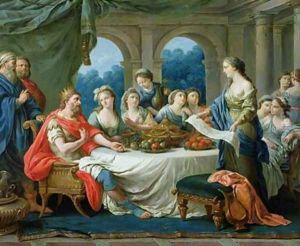Francois Langrenee Paintings
Francois Langrenee, born in 1746 and passing away in 1817, was a French artist whose career straddled the late Rococo and early Neoclassical periods. Langrenee's artistic journey was significantly influenced by the shifting tides of French art, as the extravagance of the Rococo began to give way to the more disciplined and moralizing ethos of Neoclassicism. Despite not being as widely recognized as some of his contemporaries, Langrenee's work provides a fascinating glimpse into the transitional period of French art and the evolving tastes of the period.
Langrenee's early life and training in the arts were rooted in the rich cultural atmosphere of 18th-century France, a period that prized artistic achievement and was home to a flourishing art scene. He was likely educated in the traditional French academic style, which emphasized mastery of drawing, a thorough understanding of anatomy, and the study of classical antiquity. These elements would become hallmarks of Neoclassical art, toward which Langrenee's work would gradually evolve.
Throughout his career, Francois Langrenee was known for his skill in both painting and engraving. His works often depicted historical and mythological scenes, characterized by their delicate composition, attention to detail, and the subtle interplay of light and shadow. These qualities reflected the influence of Rococo aesthetics, with its emphasis on grace, beauty, and ornamentation. However, as Langrenee's career progressed, his work began to reflect the influence of Neoclassicism, with its focus on simplicity, clarity, and an appeal to moral virtue through the depiction of heroic subjects and themes from classical history and mythology.
Langrenee's contribution to the art world of his time was notable, even if he did not achieve the same level of fame as some of his peers. His works are a testament to the transitional nature of 18th-century French art, encapsulating the shift from the playful and ornate qualities of the Rococo to the more structured and idealized vision of Neoclassicism. Despite the scarcity of detailed records about his life and the full extent of his oeuvre, Langrenee remains an intriguing figure for art historians interested in the nuances of this pivotal era in art history.
Francois Langrenee's death in 1817 marked the end of a career that spanned some of the most transformative decades in French art. His legacy, though perhaps overshadowed by more prominent figures of the time, offers valuable insights into the complexities and dynamics of French artistic expression at the cusp of modernity. Through his work, Langrenee contributed to the rich tapestry of French art, bridging the gap between two significant styles and periods, and leaving behind a body of work that continues to be appreciated by connoisseurs and scholars of French art history.
